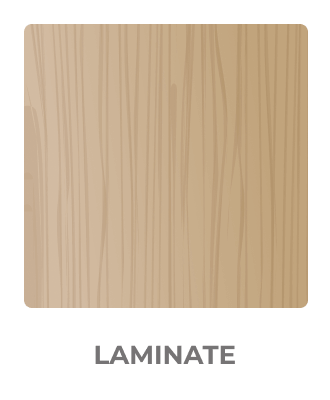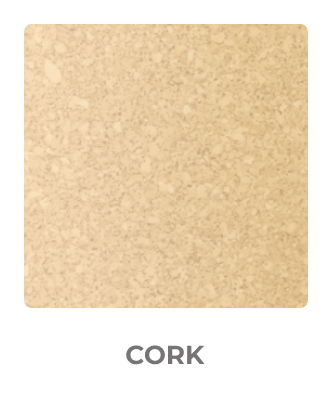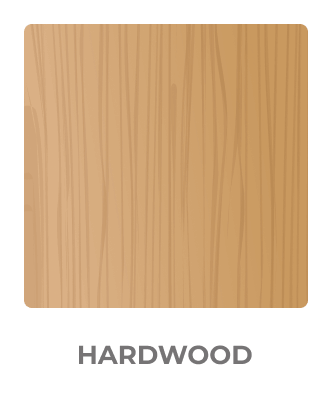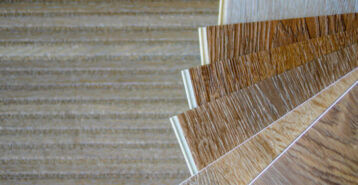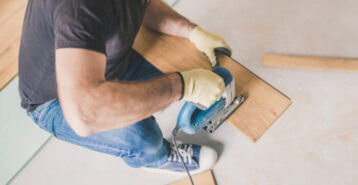Are you doing a flooring project?
Modernize can pair you with three to four pros in your area, so you can compare options and save time and money.
You love the look of hardwood floors, but the hefty price tag? Not so much. While the average price of a flooring project is $3,349, installing hardwood floors can be thousands of dollars more. So how about cheap hardwood flooring and some alternatives?
If you are on a budget or desire more environmentally-conscious materials, hand-scraped oak flooring may not be in the cards. But there are several flooring materials that are easier on the wallet, more sustainable, and Instagram-worthy when installed.
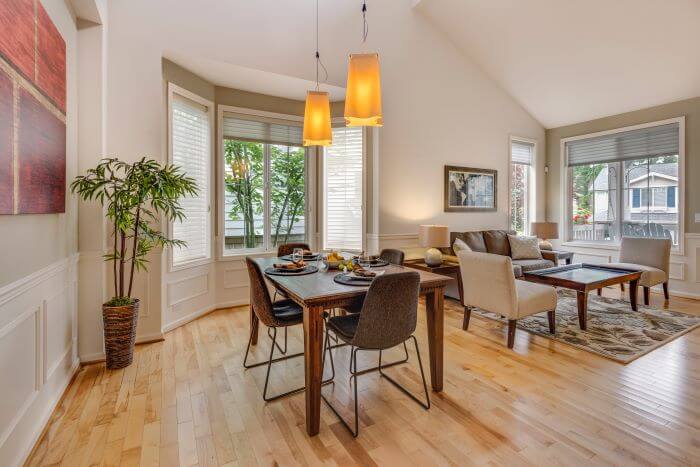
Hardwood Flooring Alternatives Cheat Sheet
| Material | Lifespan | Cost per Square Foot | Installation | Maintenance |
|---|---|---|---|---|
| Laminate | 15 to 25 years | $6 to $14 | Floating, adhesive, or staples | Sweep, microfiber mop |
| Vinyl | 10 to 25 years | $5 to $12 | Floating, adhesive | Sweep, microfiber mop |
| Bamboo | 10 to 25 years | $5 to $15 | Nail down, floating, adhesive | Sweep, damp mop, refinishing |
| Cork | 20 to 50 years | $3 to $8 | Floating, adhesive | Sweep, damp/dry mop |
| Cheaper solid hardwoods | 20 to 100+ years | $3 to $10 | Nail down, floating, adhesive | Sweep, damp mop, refinishing |
Laminate Flooring
This budget-friendly flooring option is a perennial favorite because improvements to manufacturing have made it strong, durable, and nearly identical to wood flooring. Its resistant wear layer makes it a great choice for high-traffic areas like entryways, kitchens, and living rooms.
Laminate Flooring Benefits
If you are looking for a cheap flooring alternative, laminate can check off many of your boxes.
Easier installation. Laminate is a floating floor, which means its planks lock together and rest atop your current floor or subfloor.
Eco-friendly. Laminate is recyclable and can be manufactured with recycled materials. As a floating floor, it requires no toxic adhesives to install. Check for a North American Laminate Flooring Association certification to ensure its sustainability.
Low-fuss maintenance. Wipe up any spills as they happen to prevent swelling, and sweep weekly with a soft broom. For monthly maintenance, use a microfiber mop with laminate cleaner and a little water.
How Laminate Compares to Wood Flooring
- Decorative wear layer offers more wood species looks and stains
- Its scratch- and impact-resistance makes it a smart choice for households with kids or pets
- Particleboard sublayer can swell and warp similar to hardwood flooring, so laminate is not recommended for bathrooms and laundry rooms
- Laminate cannot be refinished, which limits its average lifespan to 15 to 25 years
Average cost per square foot: $6 to $14
Vinyl Flooring
Vinyl used to get a bad rap, but improvements to its design and manufacturing make it an attractive and economical flooring option. Today’s vinyl options are durable and numerous — its strong decorative layer offers multiple colorways in matte and textured finishes that look like wood and feel comfortable underfoot.
Vinyl Flooring Benefits
Here is a breakdown of some of the top reasons to choose this versatile flooring material:
Three types to choose from. Vinyl comes in sheets, planks, and tiles. Luxury vinyl plank or tile, LVP and LVT, respectively, are popular among home builders, remodelers, and homeowners because they mimic the look of real wood and tile.
Water resistant. LVP and LVT are highly water-resistant and are great choices for active households (and can be installed in bathrooms). Water can still find a way through the planks and tiles, however, so if you are looking for flooring that is 100% waterproof, vinyl sheet flooring is your best bet.
Durable. Vinyl flooring is resistant to moisture, mold, scratches, and scuffs. When vinyl flooring shopping, look for a thicker wear layer (10 or 12 mils minimum) to maximize longevity.
How Vinyl Flooring Compares to Wood
- Very moisture- and water-resistant
- Longevity is on the lower end, 10 to 25 years, but can be maximized by regular cleaning and maintenance
Average cost per square foot: $5 to $12
Bamboo Flooring
Bamboo is often categorized as wood flooring, but it is really a type of grass. Native to tropical regions with heavy rainfalls, bamboo is harvested into long, thin strips that are boiled and dried. Strips are glued together, sanded, then cut into floor planks.
Bamboo Flooring Benefits
Most similar to wood. For those who prefer the richness and warmth of real wood, bamboo is hard to beat as a flooring alternative. Bamboo’s texture is unique and feels comfortable underfoot.
More sustainable. Bamboo is a fast-growing grass, taking only five to seven years for it to reach maturity. It is a renewable resource that is more earth-friendly than hardwood — look for the Forestry Stewardship Council certification seal to be sure your product meets sustainable harvesting standards.
Find the Right Contractor for Your Flooring Project
Whether you’re ready to begin your project now or need some expert advice, our network of contractors are here to help. With a few simple questions, we’ll find the best local professionals for you
Long-lasting. Bamboo can be refinished multiple times, depending on the specific species, adding to its 10- to 25-year lifespan.
How Bamboo Flooring Compares to Wood
- Available in solid and engineered varieties as well as planks of various sizes
- Can be weaker and less durable. Tip: Look for Moso bamboo and stay away from planks that have been harvested prematurely to avoid denting or warping.
- Bamboo is limited to a few tonal shades
Average cost per square foot: $5 to $15
Cork Flooring
Known for its tawny warm hues and moisture resistance, cork is resurging in popularity as a flooring material. Look no further than architectural icon Frank Lloyd Wright for a cork flooring enthusiast, who included it in his Fallingwater masterpiece.
Cork flooring is made exclusively from the cork oak tree by harvesting the trees’ outer layers of bark. The bark is ground, molded into sheets, then baked at high temperatures and cut into tiles.
Cork Flooring Benefits
Environmentally conscious. Cork oak trees are not cut down when harvested — tree bark can be harvested multiple times, making cork a highly renewable resource.
Highly durable. Cork is moisture- and mold-resistant, making it a great choice for humid climates. It also withstands high traffic, pet scratches, and breakage from impacts.
Easy to install. Cork tiles can be installed over existing and level flooring using an adhesive or the click-and-lock method.
How Cork Flooring Compares to Wood
- Resistant to moisture and pets
- Will swell and warp from excessive moisture or standing water
- Cannot be sanded and refinished
- Lifespan is smaller than wood but still impressive at 20 to 50 years
Average cost per square foot: $3 to $8
Lower-Priced Hardwood Flooring
After reviewing all these options, if you still have your heart set on hardwood floors, you have options. Here are several cheap hardwood flooring choices that are beautiful and budget-friendly.
Pine Flooring
Pine is considered a softer wood because of its lower Janka rating, a classification system that measures hardness. But do not let its rating fool you — if you clean and maintain this type of floor regularly and use felt pads under furniture, this classic wood flooring can be durable and relatively long-lasting in lower-traffic areas.
Average cost per square foot: $3 to $6
Maple Flooring
With its fine-grained and light appearance, maple flooring has many fans. If you prefer going a few shades darker, that is fine too, as maple stains well. Or select planks that show off maple’s darker streaks and unique marks for a bespoke look.
Average cost per square foot: $3 to $10
Birch Flooring
Birch shares the top spot with oak flooring in popularity, and it is easy to see why. It is more durable than oak, on-trend with its lighter-hued grain, and a fraction of the cost.
Average cost per square foot: $5 to $8
Weighing Your Flooring Options
When considering a cheaper flooring option, think about which rooms will get the new floors and how they will be used, keeping in mind the amount of foot traffic, moisture levels, and proximity to water. A professional flooring installer can help point you in the right direction so you can select the best flooring for your lifestyle and budget.
Find the Right Contractor for Your Flooring Project
Whether you’re ready to begin your project now or need some expert advice, our network of contractors are here to help. With a few simple questions, we’ll find the best local professionals for you
Reviews from Real Homeowners
Welcome to Homeowner Resources! We are the Modernize blog. Modernize pairs more than 3 million homeowners a year with pre-vetted contractors in their area. This blog started because we believe homeowners should know everything about their homes, from how their HVAC works to which front door colors they might love. On Homeowner Resources, you can find information on every part of your home, right down to how you can negotiate with contractors to get the best price. Here's more about the blog.
Need a contractor? Learn more about how Modernize finds the right pro for you.
